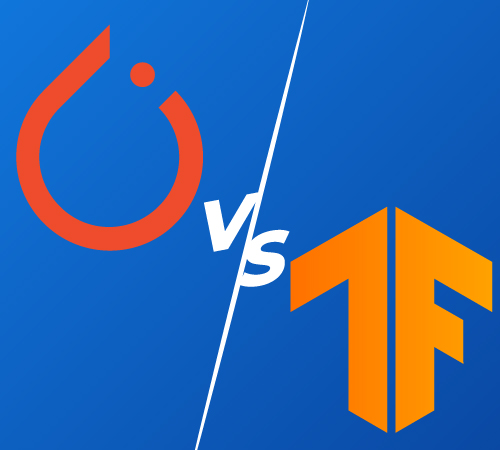PyTorch vs. TensorFlow is a longstanding point of a contentious debate to determine which deep learning framework is superior. Both are the best frameworks for deep learning projects, and engineers are often confused when choosing PyTorch vs. TensorFlow.
PyTorch and TensorFlow models have developed so quickly over a short lifetime that the debate is ever-evolving. Where PyTorch has a reputation for being research-focused, TensorFlow has a reputation for being an industry-focused framework.
So, which deep learning framework is superior? Should you use PyTorch, or TensorFlow works best for your deep learning project? This guide walks through the differences between PyTorch and TensorFlow and how you can pick the proper framework.
PyTorch Vs. TensorFlow: Key Differences
TensorFlow and PyTorch are the most popular deep learning frameworks today. The open-source libraries are used by ML engineers, data scientists, developers, and researchers in various projects. Below are the main differences between the PyTorch deployment framework and the end-to-end TensorFlow extended platform.
Performance Comparison
Both PyTorch and TensorFlow are two popular deep learning models that offer fast performance; however, they have their own advantages and disadvantages.
PyTorch has become the best platform with faster performance than Python, whereas TensorFlow offers excellent support for symbolic manipulation. TensorFlow is a good choice for users wanting to perform high-level operations.
TensorFlow has the upper hand over PyTorch as the former has the ability to take advantage of GPU(s) connected to your system. Ideally, TensorFlow provides better performance in this case.
Debugging
PyTorch and TensorFlow are the two best artificial intelligence and deep learning architectures that differ in debugging. PyTorch uses a standard Python debugger, ensuring users do not have to learn other debuggers.
The eager mode of PyTorch allows immediate execution, and you can use debugging tools like PyCharm, ipdb, and PDB debugger, making it easy to debug.
On the contrary, there are two ways for TensorFlow debugging. The user must learn the TF debugger or request the variable from the sessions to execute the code before debugging it.
Mechanism: Graph Definition
TensorFlow works on a static graph concept that allows users to define computation graphs and run machine learning models. On the other hand, PyTorch is better at dynamic computational graph construction. It means the graphic is constructed during operation execution.
In the case of graph construction, PyTorch stands above TensorFlow. Constructing graphs with PyTorch is less complex compared to the end-to-end TensorFlow extended platform.
Verdict: Both frameworks have active communities, good documentation, and many learning resources. With that in mind, you won’t be wrong choosing either PyTorch or TensorFlow. If you want to dive deep into how to accomplish the project and use the framework with core deep learning features, contact Inferenz experts.
What Should You Choose: PyTorch Or TensorFlow
Choosing between the two powerful and mature deep learning libraries can be complex for users. Here we’ve briefly listed the advantages and disadvantages of open-source deep learning frameworks.
Advantages & Disadvantages of PyTorch
Advantages
- Pythonic in Nature: All the PyTorch codes deployed are pythonic in nature, meaning they are similar to python elements.
- Flexibility and Ease of Use: The deep learning framework based on Python offers easy-to-use APIs and is simple.
- Easy to Learn: Compared to TensorFlow, PyTorch is easy to learn as its syntax resembles Python. Additionally, it allows quicker prototyping than TensorFlow.
- Model Availability: Many publications use PyTorch, implying that machine learning and deep learning model dominates the research landscape.
- Community Support: The active community and forums help developers to work, share, and develop PyTorch projects quickly.
Disadvantages
- Less Extensive: Sometimes, you’ll need to convert PyTorch code/model into another model to develop an actual application.
- Visualization Techniques: The visualization option in PyTorch is not as great, and you’ll have to use existing data visualization tools or connect externally to TensorBoard. Also, PyTorch is not an end-to-end machine learning model.
Advantages & Disadvantages of TensorFlow
Advantages
- Compatibility: Unlike PyTorch, TensorFlow is compatible with many programming languages and provides third-party language binding packages for OCami, Crystal, C#, Scala, etc.
- Scalability: Thanks to the production-ready nature of TensorFlow, it can easily handle large datasets. That’s why the market share of TensorFlow has become 36.92%.
- Data Visualization: TensorFlow is an end-to-end deep learning library with strong visualization capabilities. It renders users with TensorBoard, which helps them with graphical data visualization.
- Open Source: TensorFlow is an open-source deep learning framework that allows users to use it whenever and wherever required. It is free of cost, ensuring anyone can utilize or work with it.
Disadvantages
- Frequent Updates: TensorFlow was developed by Google and is widely preferable; however, the frequent updates and time-to-time uninstallation and reinstallation have become a headache for users.
- Computation Speed: TensorFlow lags at providing high computation speed and usability compared to many deep learning frameworks on the market.
Choose The Best Deep Learning Framework
The TensorFlow vs. PyTorch debate is longstanding. The choice between the two will depend on the specific use case. For instance, if you’re looking for a platform that supports dynamic computation graphs, go ahead with PyTorch.
On the contrary, TensorFlow also is mature with multiple popular deep learning libraries. However, you’ll have to spend more time understanding and learning the basics of deep learning concepts.
If you’re confused about which framework you should choose for your project and who wins the PyTorch vs. TensorFlow debate, get in touch with our machine learning and deep learning experts.
FAQs About TensorFlow Or PyTorch
Which is faster: PyTorch vs. TensorFlow?
For small and medium datasets, PyTorch and TensorFlow provide multiple similar features. However, PyTorch is very simple and much faster for prototyping.
Is PyTorch good for deep learning?
PyTorch runs on top of TensorFlow as it provides high speed and flexibility for deep neural network implementation, making it an ideal choice.
Is PyTorch more popular than TensorFlow?
PyTorch currently dominates the research landscape, indicating its popularity among users. Even though TensorFlow 2.0 makes it easy for researchers to utilize TensorFlow, PyTorch does give any reason to researchers to try other frameworks.














